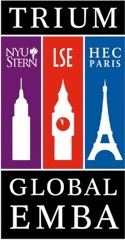What is Social Currency? (Graham Brown mobileYouth.org)
 Sunday, May 10, 2009 at 5:17PM
Sunday, May 10, 2009 at 5:17PM Check out this SlideShare Presentation:
 Proud graduate of the TRIUM global executive MBA from HEC-Paris, the London School of Economics, and NYU-Stern. Click here for perspective on TRIUM.
Proud graduate of the TRIUM global executive MBA from HEC-Paris, the London School of Economics, and NYU-Stern. Click here for perspective on TRIUM.
 Longtime member of the Washington DC chapter of the World Affairs Council.
Longtime member of the Washington DC chapter of the World Affairs Council.
 Sunday, May 10, 2009 at 5:17PM
Sunday, May 10, 2009 at 5:17PM Check out this SlideShare Presentation:
 Tuesday, November 25, 2008 at 10:02AM
Tuesday, November 25, 2008 at 10:02AM I've written and taught a lot about Wal-Mart's missteps in its globalization strategies, looking particularly hard at the situation in Germany, which yielded to a perfect confluence of a Porter Five Forces analysis and my five forces of customer experience analysis. (For more info on the Five Forces of CEM, contact me.)
 Thursday, October 23, 2008 at 9:08AM
Thursday, October 23, 2008 at 9:08AM As a part of my model of customer forces (imagine the Porter Five Forces sweater turned inside-out), I hang corporate social responsibility on the hook of the customer's process of reflecting on a company's values.
 Monday, September 29, 2008 at 9:36AM
Monday, September 29, 2008 at 9:36AM Pankaj Ghemawat of IESE has a nice series of videos on the Financial Times web site on globalization strategies. Click here for the first video, and here for the second.
 Saturday, September 27, 2008 at 11:51AM
Saturday, September 27, 2008 at 11:51AM I was poking around the internet today to get some idea about the distressed asset strategies that JP Morgan is employing regarding WaMu and -- potentially -- Wachovia. I found this fascinating link that looks at the relative merits of the class capital asset pricing model (CAPM). It rains hard on CAPM, and makes some really interesting observations about what market behaviors of stock pricing and purchasing really mean.
 Wednesday, September 10, 2008 at 3:55AM
Wednesday, September 10, 2008 at 3:55AM It's been said that companies have a choice. Compete on customer intimacy, product excellence, or operational superiority. Pick one, but it's just too hard to do all three.
 Tuesday, September 9, 2008 at 8:44AM
Tuesday, September 9, 2008 at 8:44AM This heartwarming story, about blind photographers in Israel as recounted in the CNN video below, has lessons for decision-makers:
 Sunday, September 7, 2008 at 2:57PM
Sunday, September 7, 2008 at 2:57PM  Just got back from a grand tour with my wife of part of Oregon's superb wine country. Thought I'd share some thoughts about wine and experience management.
Just got back from a grand tour with my wife of part of Oregon's superb wine country. Thought I'd share some thoughts about wine and experience management.
 Tuesday, August 26, 2008 at 9:38AM
Tuesday, August 26, 2008 at 9:38AM Russia just voted to recognize the independence of two regions of Georgia, South Ossetia and Abkhazia.
 Wednesday, August 6, 2008 at 6:33PM
Wednesday, August 6, 2008 at 6:33PM  Tuesday, August 5, 2008 at 7:38AM
Tuesday, August 5, 2008 at 7:38AM Apple has been a beautiful company. People think of it as a superb marketer. It is. It is also a super design company. Apple, finally, is also a world-class logistics company.
 Tuesday, July 29, 2008 at 1:03PM
Tuesday, July 29, 2008 at 1:03PM So I was catching up on my Asia news while in Singapore recently, to learn that the ASEAN countries are essentially on notice that they'd better put-up-or-shut-up in creating a more integrated regional trading force. (ASEAN is sort of NAFTA East, but excludes China and India, although they are party to regional discussions with ASEAN.) I've been tracking this for a long time because I predict the Asian countries in ASEAN (and India and China, but especially the fast-rising Malaysia, Singapore, Thailand and Viet Nam) are in a position to both grow and be more powerful on the world political stage via a combination of economic emergence and tighter integration. With all the hand-wringing in the West about the impact of China as an economic superpower, I think China's got nothing on what can happen with ASEAN. After all, the structural and resource disparities among these countries create an ideal opportunity for partnership. Outside of India and China, ASEAN countries have labor, transportation, logistics and targeted industrial support well in hand -- and it's only going to get better.